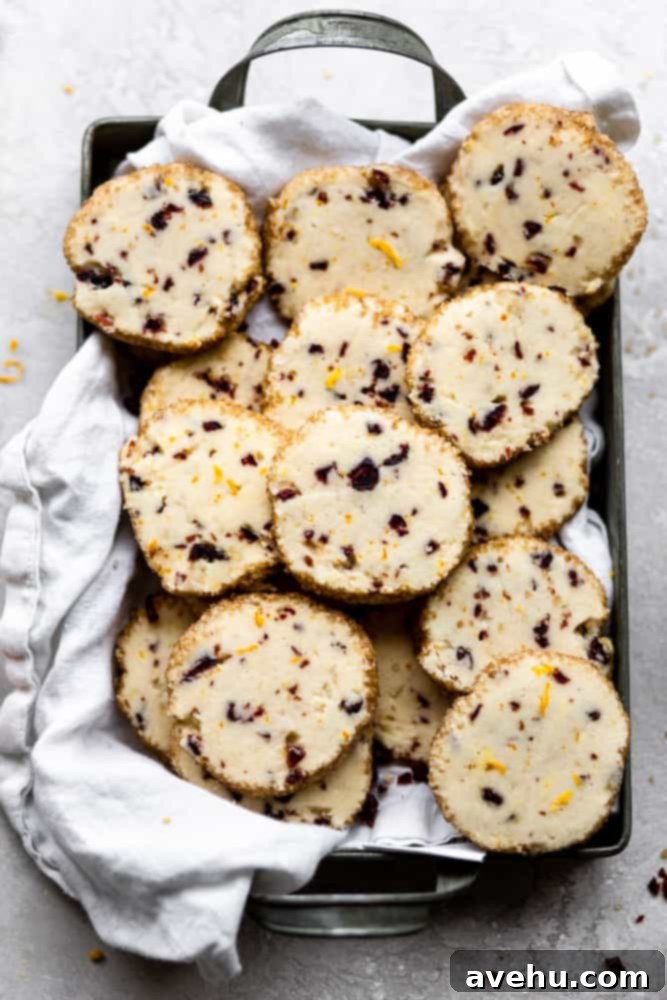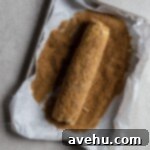Easy & Festive Cranberry Orange Shortbread Cookies: A Melt-in-Your-Mouth Holiday Treat
Get ready to infuse your holiday season with the delightful aroma and exquisite taste of these **Cranberry Orange Shortbread Cookies**. Crafted for perfection, they combine the tangy sweetness of dried cranberries with the bright, citrusy notes of fresh orange zest. Each bite delivers a buttery, melt-in-your-mouth shortbread experience, complemented by an irresistible crunchy exterior from a generous roll in raw sugar. These cookies aren’t just a treat; they’re a celebration in every crumb, guaranteed to become a cherished addition to your festive baking repertoire!
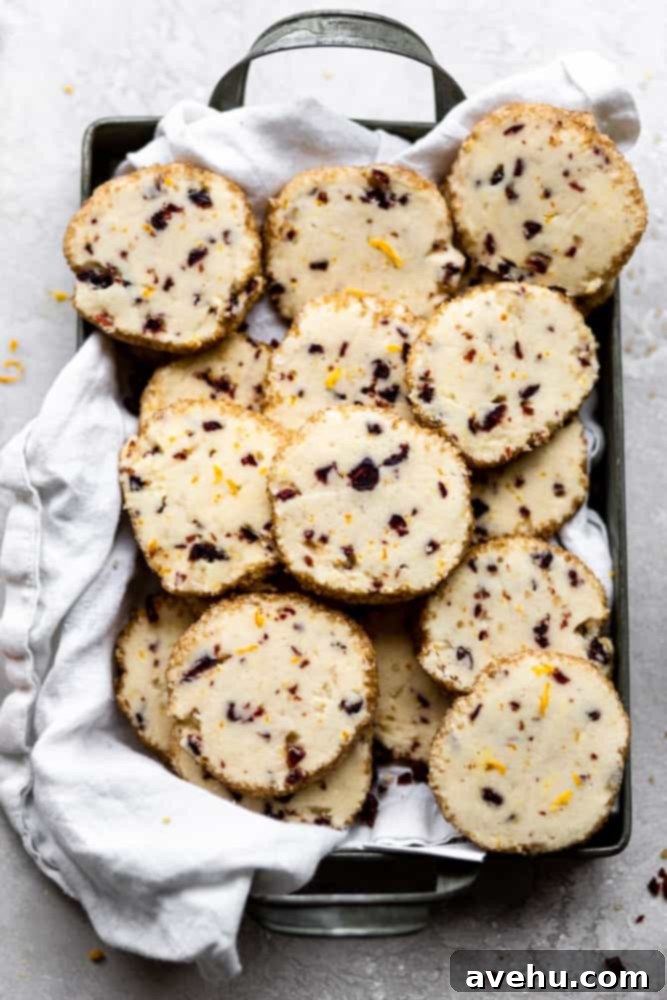
As a trained pastry chef, many people might assume I spend my days crafting the most complex and intricate desserts imaginable, adorned with gravity-defying decorations and countless delicate layers. However, the reality is quite the opposite! My true passion lies in creating simple, approachable baked goods that still manage to feel elevated and special, offering gourmet taste without unnecessary complications. This philosophy rings especially true during the bustling holiday season, when time is a precious commodity and heartfelt homemade treats are most desired.
That’s precisely why these exquisite Cranberry Orange Shortbread Cookies are such a perfect fit for my kitchen and yours. They epitomize the elegance of simplicity. The dough for these delightful shortbreads masterfully combines the classic, festive pairing of plump, chewy dried cranberries and the vibrant, aromatic zest from fresh oranges. This harmonious duo infuses the cookies with a bright, tangy sweetness that is utterly irresistible. But the magic doesn’t stop there! Before baking, each cookie log is generously rolled in turbinado sugar. If you’re unfamiliar with turbinado sugar, it’s essentially a type of raw cane sugar known for its larger crystals and a delightful, subtle caramel-like flavor. Its robust crystals don’t melt significantly during baking, ensuring a wonderfully sweet, shimmering, and satisfyingly crunchy texture on the exterior of every single cookie. This combination of tender interior and crispy, sugary coating is what makes these holiday cookies truly unforgettable.
Prepare yourself for a truly remarkable texture experience with every bite. Like all excellent shortbread, these cranberry orange cookies are designed to literally dissolve in your mouth, leaving behind a rich, pure buttery flavor that lingers beautifully. This delicate, tender, and crumbly consistency is a hallmark of traditional shortbread, a culinary achievement attained through precise ratios of butter, sugar, and flour. The absence of eggs, a distinguishing characteristic of shortbread, keeps the texture exceptionally light and delicate, allowing the butter to shine.
While this vibrant cranberry and orange combination is undeniably a holiday favorite, celebrated for its festive charm, the inherent versatility of shortbread means you can easily experiment with different flavor profiles to suit any occasion or personal preference. Don’t limit yourself to just one type of cookie! Shortbread is a blank canvas for creativity. For instance, you could explore variations such as these rich and tempting chocolate orange shortbread cookies, offering a decadent twist. Or, perhaps a batch of refreshing lemon shortbread cookies, bursting with bright citrus notes, would be more to your liking. For a more sophisticated option, consider these elegant pistachio shortbread cookies, which add a nutty, earthy dimension. Offering a fun variety of different flavors ensures there’s a melt-in-your-mouth treat for everyone on your guest list to enjoy, making your cookie platter a true delight.
Why You Will Adore This Cranberry Orange Shortbread Recipe
There are countless reasons to fall in love with these festive shortbread cookies, making them a perfect staple for your holiday baking and beyond. Their charm extends far beyond just their delicious taste:
- Effortlessly Simple to Master: This recipe is a dream for bakers of all skill levels. It calls for just a few basic, readily available ingredients and straightforward steps, making it perfect for both novice bakers taking their first steps into holiday baking and seasoned pros looking for an easy yet impressive treat. You won’t find any complicated techniques or obscure ingredients here, just pure baking joy!
- Unforgettable Melt-in-Your-Mouth Texture: The hallmark of a truly great shortbread cookie is its ability to melt delicately in your mouth, and these cookies deliver precisely that experience. Their tender, pure buttery crumb is simply divine, creating a luxurious mouthfeel that contrasts beautifully with the delightful crunchy sugar coating. It’s a texture sensation that keeps you coming back for more.
- Vibrant Seasonal Flavor Burst: The classic combination of tangy, sweet cranberries and bright, aromatic orange zest sings with holiday cheer and fresh flavor. It’s a harmonious blend that feels both deeply traditional and wonderfully vibrant, perfectly capturing the spirit of the season.
- Perfect for Thoughtful Holiday Gifting: These shortbread cookies not only taste incredible but also hold up wonderfully, making them an ideal candidate for homemade edible gifts. Stack them neatly in decorative tins, elegant cello bags, or small boxes, tie with a festive ribbon, and spread some heartfelt joy to friends, family, and neighbors!
- Clever and Delicious Use for Dried Cranberries: If you often find yourself with a bag of dried cranberries lingering in your pantry after Thanksgiving or other occasions, this recipe offers a delicious, practical, and incredibly satisfying way to use them up. You’ll transform them into something truly special and crave-worthy.
- Ultimate Make-Ahead Flexibility: This recipe is incredibly adaptable to busy schedules. The dough can be prepared entirely in advance and chilled in the refrigerator or even frozen, giving you ultimate flexibility during hectic times. This means fresh-baked cookies are just minutes away whenever the craving strikes or unexpected guests arrive, making holiday entertaining a breeze!
Understanding the Shortbread Cookie: A Classic Scottish Delight with a Rich History
Shortbread, at its heart, is a beloved traditional Scottish biscuit renowned worldwide for its distinct rich, pure buttery flavor and wonderfully crumbly texture. Its enduring simplicity is truly its genius, typically relying on just three core ingredients that, when combined correctly, create something truly magical: butter, sugar, and flour. The classic ratio, often fondly remembered as the “1 part sugar, 2 parts butter, and 3 parts flour” rule, is a foundational principle in traditional shortbread making. If you take a closer look at the recipe provided below, you’ll discover that these are the precise ratios I’ve meticulously adopted, ensuring that authentic, melt-in-your-mouth shortbread experience that connoisseurs adore.
What truly sets shortbread apart from other cookie varieties is its unique composition. It features a notably high butter content and, crucially, the complete absence of leavening agents like baking powder or baking soda, as well as eggs. This distinctive combination is entirely responsible for its characteristic dense yet incredibly tender and crumbly crumb, making it unmistakably different from most cookies. It’s this lavish amount of butter, which “shortens” the gluten strands in the flour (prevents them from developing too much), that earned it the name “shortbread”—a term referring to the rich, crumbly texture that results from a high fat content.
Historically, shortbread was considered a luxury, often reserved for special occasions like Christmas, Hogmanay (New Year’s Eve), and weddings. Its rich nature made it a symbol of hospitality and celebration. Today, it remains a cherished treat globally, particularly during festive periods. I find immense joy in baking shortbread during this particular time of year, as its comforting richness and traditional appeal perfectly complement the festive atmosphere of the holidays. However, for the rest of the year, when a lighter, perhaps fruitier bite is desired, I love to whip up these exquisite raspberry lemon linzer cookies, offering a different but equally delightful baking adventure that keeps my kitchen fragrant year-round.
Essential Ingredients for Your Cranberry Orange Shortbread
Crafting the perfect batch of Cranberry Orange Shortbread Cookies requires a few key ingredients, each playing a vital role in achieving their signature flavor, delicate texture, and irresistible crunch. Quality ingredients are paramount for the best results. Here’s a detailed look at what you’ll need and why each component is important:
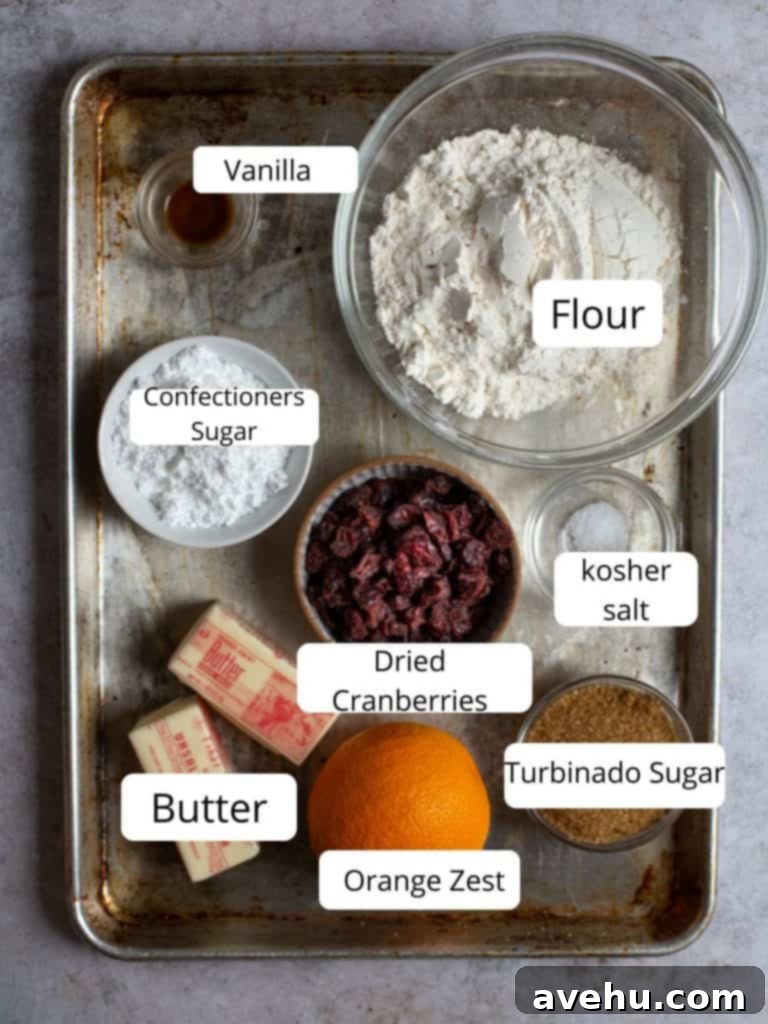
- Unsalted Butter: This is unequivocally the star of any shortbread recipe! Using high-quality unsalted butter is crucial, as it provides the primary flavor and contributes significantly to that signature tender, rich, and crumbly texture. Using unsalted butter also allows you to precisely control the overall salt content in your cookies. Ensuring the butter is at true room temperature (soft enough to indent with a finger, but not greasy or melted) is absolutely crucial for proper creaming with the sugar, which incorporates air and creates a lighter dough. Need a quick tip to soften butter in a pinch? Learn how to soften butter quickly if you forgot to take it out in advance!
- Confectioners’ Sugar (Powdered Sugar): Unlike regular granulated sugar, confectioners’ sugar is finely milled to a powdery consistency and typically contains a small amount of cornstarch. This fine texture results in a remarkably light and delicate cookie that truly melts in your mouth, contributing significantly to the delicate, tender crumb that defines authentic shortbread. The cornstarch also helps prevent excessive gluten development, enhancing the “short” quality of the bread.
- Fresh Orange: We’re after the zest—the brightly colored outer layer of the orange peel. Freshly zested orange brings an incredible burst of aromatic, tangy, and sweet citrus flavor that perfectly complements the tartness of the cranberries and the richness of the butter. Always use fresh oranges for zesting; pre-packaged zest or extracts won’t deliver the same vibrant, natural aroma and taste.
- Dried Cranberries: These provide a delightful chewiness and a welcome tart counterpoint to the overall sweetness of the shortbread. Be sure to chop them up into smaller pieces to ensure an even distribution throughout the dough. This way, every single bite gets a pleasant taste of cranberry goodness, preventing large clumps.
- Vanilla Extract: A classic and indispensable enhancer in almost all baking, vanilla extract deepens and rounds out the overall flavor profile of the cookies. It adds a warm, inviting, and subtly sweet note that pairs beautifully with the bright orange and tangy cranberry, creating a more complex and satisfying taste.
- All-Purpose Flour: This is the ideal flour to use for shortbread cookies. Its moderate protein content provides just enough structure to hold the cookies together without making them tough or chewy, allowing them to remain tender and crumbly as traditional shortbread should be. Accurate measurement of flour is critical (preferably by weight or spoon-and-level method).
- Kosher Salt: A small but mighty ingredient, a pinch of kosher salt is essential in virtually all baking recipes! It plays a crucial role in balancing the sweetness, enhancing all the other flavors (especially the butter and fruit), and prevents the cookies from tasting flat or overly sugary.
- Turbinado Sugar or Raw Sugar: This coarse-grained sugar is specifically used for rolling the exterior of the cookie logs. Its larger, crystalized structure and golden hue provide a fantastic textural contrast, adding a delightful crunch and an extra layer of sweetness to the outside of each cookie. Importantly, turbinado sugar holds its shape and doesn’t melt completely during baking, ensuring that satisfying crunchy bite. It’s also commonly known as “Sugar in the Raw.”
Important Note on Cranberries: This recipe specifically calls for dried cranberries, and this is a deliberate choice. I strongly advise against using fresh or frozen cranberries, as their significantly higher moisture content would drastically alter the dough’s consistency. This could lead to a soggy, greasy, or inconsistent shortbread texture that simply won’t yield the desired melt-in-your-mouth result. Stick strictly to dried cranberries for optimal results and the perfect shortbread texture!
Crafting Your Perfect Cranberry Orange Shortbread Cookies: A Step-by-Step Guide
Making these delightful shortbread cookies is a surprisingly straightforward process, delivering impressive results with minimal effort. Whether you prefer the convenience of a stand mixer, the simplicity of a hand mixer, or the hands-on satisfaction of kneading the dough by hand, these steps will guide you to buttery, flavorful perfection. Precision in each step is key to achieving that signature shortbread texture.
1. Prepare Your Dough for Optimal Flavor and Texture
Begin by preheating your oven to 350°F (175°C) and lining two rimmed baking sheets with parchment paper; this ensures a non-stick surface and even baking. In a medium-sized mixing bowl, or the bowl of your stand mixer fitted with the paddle attachment, combine the softened unsalted butter and confectioners’ sugar. Start mixing on low speed, gradually increasing to medium, until the mixture is beautifully light, fluffy, and well-combined. This creaming process should take approximately 30 seconds to 1 minute, incorporating essential air into the dough. Next, carefully add the fresh orange zest and vanilla extract, mixing just lightly until they are evenly distributed throughout the buttery mixture, ensuring their aromatic essences permeate the dough. Finally, incorporate the chopped dried cranberries, the all-purpose flour, and the kosher salt. Continue mixing on low speed until a firm, cohesive dough forms. It’s crucial to avoid overmixing once the flour is added, as excessive mixing can develop gluten, leading to tougher, less tender cookies.
2. Shape and Chill the Dough Log – A Crucial Step
Once your dough is perfectly prepared, turn it out onto a clean, lightly floured surface. Using your hands, gently yet firmly shape the dough into a uniform log. Aim for a diameter of approximately 1.5 to 2 inches; consistency in shape leads to uniformly sized cookies. For an extra helping hand in achieving a perfectly round and even log, gently wrap the dough in plastic wrap or parchment paper and then roll it back and forth on your countertop, applying light, even pressure as you would with a rolling pin. This technique helps compact the dough and creates a dense, uniform shape. Once shaped, wrap the dough tightly again in plastic wrap (or fresh plastic wrap if you used it for shaping) and chill it thoroughly in the refrigerator for at least 1 hour. For best results and maximum ease of slicing, I recommend chilling it overnight. Chilling is a crucial step that not only solidifies the butter, preventing the cookies from spreading excessively and losing their shape during baking, but also allows the flavors to fully meld and deepen, enhancing the overall taste.
3. Coat in Sugar and Slice for Perfect Portions
After the dough has thoroughly chilled and is firm, remove it from the refrigerator. Pour the turbinado sugar onto a rimmed baking sheet or a wide, shallow dish, creating an even layer. Remove the chilled dough log from its plastic wrap and roll it all over the turbinado sugar, ensuring every inch of the surface is completely and generously covered. The sugar will adhere readily to the cold dough, creating that wonderful crunchy crust that will caramelize slightly in the oven. Next, transfer the sugar-coated log to a cutting board. Using a long, sharp serrated knife and employing a gentle sawing back and forth motion, carefully slice the log into uniform rounds. Aim for slices that are approximately 1/4 to 1/2 inch thick. Consistency in thickness is paramount for even baking, so take your time and try to keep your slices as uniform as possible. If the dough is too hard to slice cleanly, let it sit at room temperature for 5-10 minutes to soften slightly before proceeding.
4. Bake to Golden Perfection and Cool
Carefully arrange the sliced cookie dough pieces onto your parchment-lined baking sheets, ensuring you leave about 1.5 inches between each cookie to allow for slight spreading without them touching. Place the baking sheets in your preheated oven at 350°F (175°C) and bake for 10-12 minutes. The cookies are ready when their edges are lightly golden, and the centers appear set and no longer wet. Shortbread typically won’t brown significantly on top, retaining its characteristic pale, buttery hue. Once baked, remove the baking sheets from the oven and let the cookies cool on the sheet for about 5-10 minutes. This crucial resting period allows them to firm up slightly, preventing breakage when you transfer them. After this initial cooling, gently transfer the cookies to a wire rack to cool completely. They will become wonderfully crisp-tender as they reach room temperature, ready for enjoying!

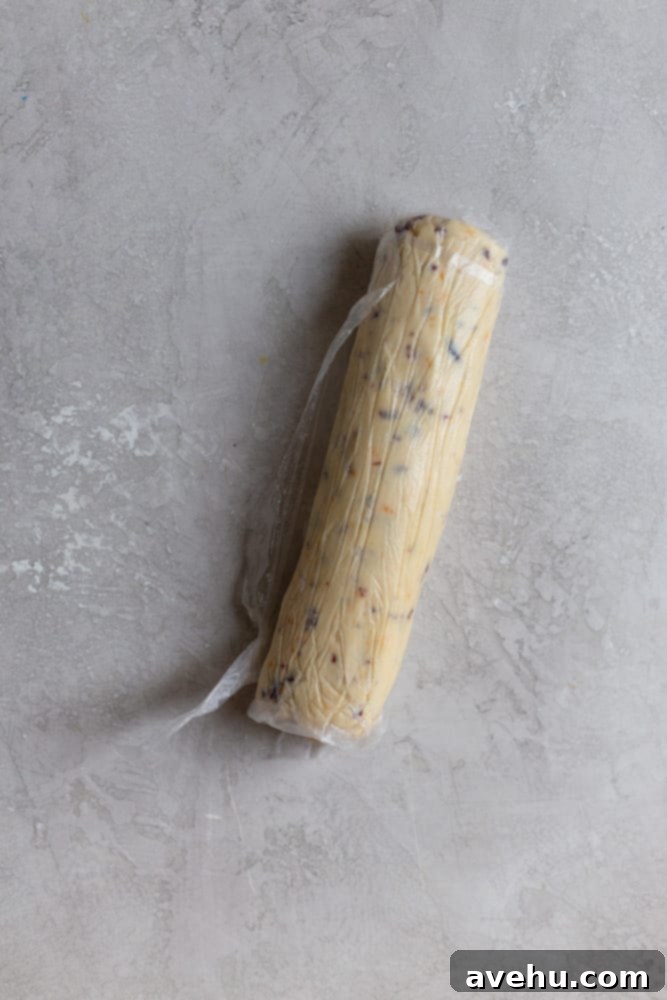
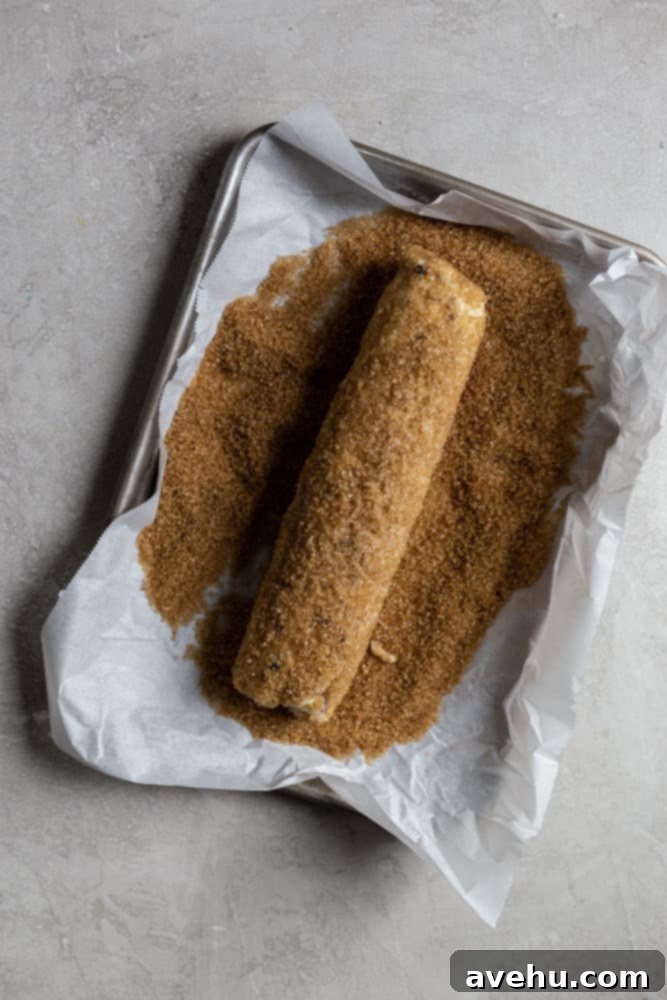
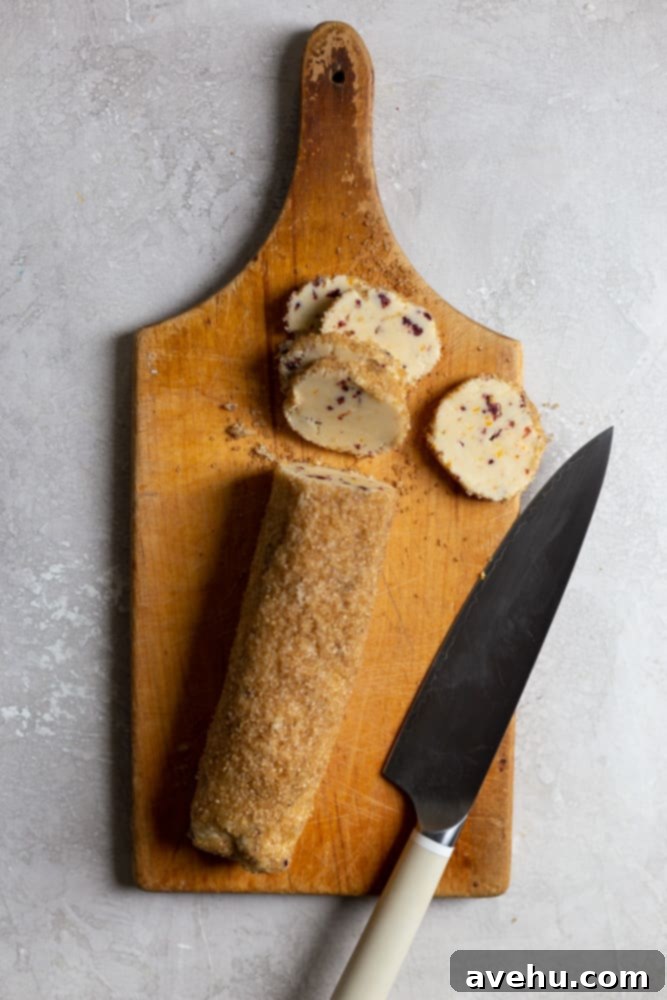
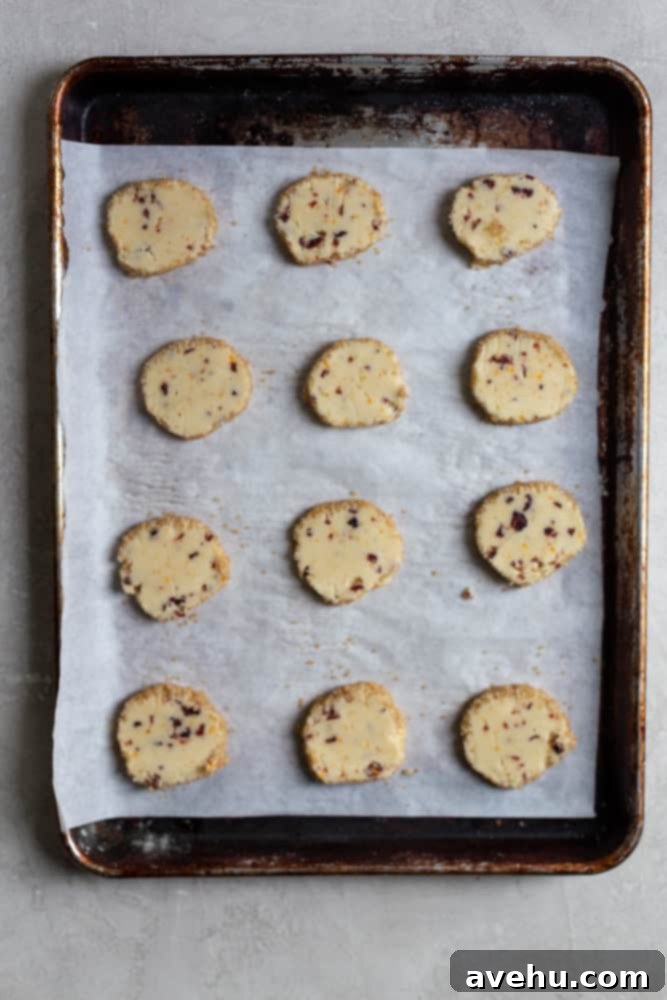
Storing and Freezing Instructions for Maximum Freshness
One of the many appealing qualities of these Cranberry Orange Shortbread Cookies is their excellent shelf life and freezer-friendliness, making them incredibly versatile for preparing ahead of time, ensuring you always have a delightful homemade treat on hand, or for extending their enjoyment over a longer period.
Storing Baked Cookies: Once your cranberry orange shortbread cookies have completely cooled to room temperature, arrange them in an airtight container. You can stack them carefully, placing a piece of parchment paper between layers to prevent them from sticking together. Stored this way at room temperature, they will retain their delightful flavor, crisp-tender texture, and characteristic crunch for up to 5 days. Keeping them sealed prevents them from becoming stale.
Freezing Unbaked Dough: This is a fantastic and highly recommended make-ahead option that offers incredible convenience, especially during busy holiday periods. You can prepare the dough log entirely, roll it in turbinado sugar as instructed, then wrap it very tightly in at least two layers of plastic wrap, followed by an additional layer of aluminum foil, or by placing it in a sturdy freezer-safe bag. The unbaked dough can be frozen for an impressive duration of up to 2 months. When you’re ready to bake, there’s no need for a full thaw! Simply remove the log from the freezer, let it sit at room temperature for about 10-15 minutes (just enough to make it pliable and easy to slice without crumbling), then slice and bake as directed. You’ll have fresh-baked shortbread in minutes!
Freezing Baked Cookies: You can also freeze the completely baked and cooled cookies. To do this effectively, arrange the cooled cookies in a single layer on a baking sheet and freeze them until they are solid (this process is called flash-freezing and prevents them from sticking together when stored). Once individually frozen, transfer them to a freezer-safe airtight container or bag, separating layers with parchment paper for protection. They will keep beautifully in the freezer for up to 2 months. To enjoy, simply remove the desired number of cookies from the freezer and thaw them at room temperature for about 30 minutes before serving. Freezing them this way means you always have a delicious homemade treat ready for unexpected guests, last-minute gifting, or a spontaneous craving for something sweet.
Frequently Asked Questions About Cranberry Orange Shortbread Cookies
Here are answers to some common questions you might have while preparing these delicious holiday cookies, ensuring your baking experience is as smooth and successful as possible:
- Do I really need to chill the shortbread dough?
- Absolutely, yes! Chilling the shortbread dough is a non-negotiable step that is fundamental to the success of this recipe. It serves several crucial purposes:
- Prevents Spreading: The primary reason is to firm up the butter in the dough. When cold, the butter melts slower in the oven, preventing the cookies from spreading excessively (a phenomenon often referred to as “blooming”) and becoming flat or misshapen blobs. A firm, chilled dough holds its intricate shape much better, resulting in beautifully defined edges and a consistent thickness.
- Enhances Texture: Chilling allows the dough to rest, which relaxes the gluten strands in the flour. This relaxation contributes significantly to the tender, crumbly, melt-in-your-mouth texture that is the hallmark of traditional shortbread.
- Deepens Flavors: The chilling period also allows all the wonderful flavors—the vibrant orange zest, the tangy cranberries, and the rich vanilla—to meld and deepen throughout the dough, creating a more harmonious and pronounced taste in the final baked cookie.
Skipping this step often leads to disappointing results, including flat, greasy, misshapen, and less flavorful cookies. Patience during chilling is truly rewarded!
- Can I add in other ingredients or substitute the cranberries and orange zest?
- Totally! Shortbread is incredibly versatile and makes a fantastic base for customization, allowing you to tailor flavors to your exact preferences or the season. While the cranberry and orange combination is undeniably festive and delicious, feel free to get creative. You can easily swap out the dried cranberries and orange zest for other delicious dried fruits like finely chopped apricots, sweet dried cherries, tart dried blueberries, or even mini chocolate chips for a different kind of indulgence. Nuts such as finely chopped pistachios, toasted almonds, or pecans also work wonderfully, adding a delightful crunch and earthy flavor. Just ensure any additions are finely chopped or mini-sized to ensure even distribution throughout the dough and to prevent them from breaking the delicate dough structure during slicing. Experiment freely and discover your new favorite shortbread flavor combinations!
- Can I swap confectioners’ sugar for regular granulated sugar?
- I highly recommend against this substitution for this particular shortbread recipe! The choice of confectioners’ sugar (also known as powdered sugar) is intentional and absolutely crucial for achieving the unique, delicate texture of these shortbread cookies. Confectioners’ sugar is much finer than granulated sugar, which contributes directly to a more tender, delicate, and incredibly smooth crumb. Additionally, confectioners’ sugar typically contains a small amount of cornstarch (often 2-3%), which is a classic ingredient in traditional shortbread. This cornstarch further enhances the characteristic melt-in-your-mouth quality and helps prevent excessive spreading of the cookies during baking. Using granulated sugar would result in a distinctly different, often coarser, and sometimes denser texture that deviates significantly from the desired traditional shortbread experience.
- What’s the difference between a shortbread cookie and a sugar cookie?
- While both are beloved butter-based cookies, there are distinct and fundamental differences in their composition and resulting texture. The primary distinction is that traditional shortbread recipes fundamentally do not use any eggs, relying solely on butter, sugar, and flour for their structure, richness, and characteristic crumb. Shortbread is also very often made with confectioners’ (powdered) sugar, which contributes significantly to its incredibly tender, delicate, crumbly, and melt-in-your-mouth texture. Sugar cookies, on the other hand, almost always include eggs, typically use regular granulated sugar, and often contain chemical leavening agents like baking powder or baking soda. These ingredients result in a cookie that is usually slightly chewier, often crisper, and generally has a firmer texture than shortbread. Sugar cookies are also frequently rolled thin and cut into various shapes for decorating, which their sturdier dough accommodates well, unlike the more delicate shortbread.
- Why is my dough dry and crumbly?
- A dry and crumbly dough can be frustrating, especially when you’re aiming for that perfect shortbread texture, but it’s usually fixable! Several factors could contribute to this issue:
- Insufficient Mixing: Sometimes, the dough simply needs a little more time and effort to come together, especially when mixing by hand. The butter needs to be fully incorporated and dispersed. Keep mixing gently until it forms a cohesive mass that can be pressed together.
- Over-measuring Dry Ingredients: Flour is particularly prone to being over-measured if scooped directly from the bag. For the most accurate results, which are vital in baking, I highly recommend using a kitchen scale to weigh your ingredients. If you don’t have a scale, always spoon the flour into your measuring cup and then level it off with the back of a straight edge (like a knife or ruler), rather than scooping directly from the bag.
- Not Enough Butter or Cold Butter: Ensure your butter was truly at room temperature (softened) and accurately measured. Cold butter won’t cream properly, leading to a dough that struggles to come together, and simply too little fat will make the dough inherently dry.
- Low Humidity: Environmental factors like very low humidity can also dry out dough more quickly.
If your dough is too dry and crumbly, try adding 1 teaspoon of very cold water or fresh orange juice at a time, mixing briefly after each addition, until the dough just barely comes together and is pliable enough to shape without being sticky. Be very careful not to add too much liquid, as this can change the cookie’s texture.
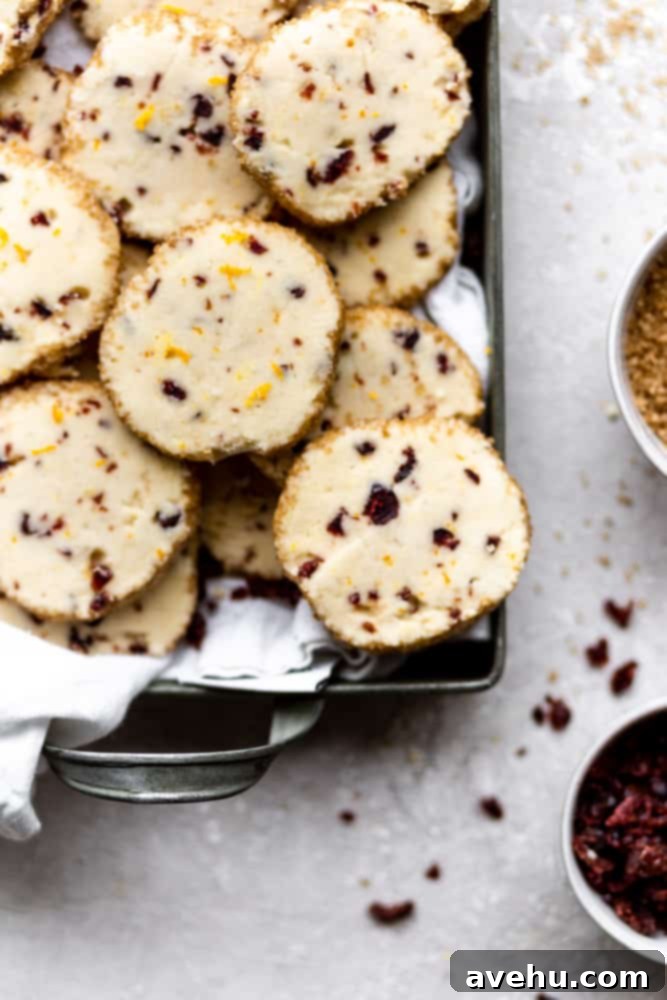
Top Tips for Shortbread Cookie Success
Achieving bakery-quality, perfect shortbread at home is simpler than you might think with these expert tips and tricks. Pay attention to these details for the best possible results:
- Effortless and Flavorful Orange Zesting: For the best results and maximum flavor, always use fresh orange zest. The oils in the zest are volatile and provide incredible aroma and taste. I highly recommend using a microplane zester or a dedicated citrus zester. These tools create finely grated zest that releases the most aromatic oils without including the bitter white pith beneath the skin. If you don’t have one, carefully slice off only the brightly colored outer layer of the orange peel with a vegetable peeler (again, avoiding the white pith), then finely mince it with a sharp knife.
- Hand-Mixing Alternative – No Mixer? No Problem!: Don’t have a stand mixer or a hand mixer? Absolutely no problem! You can successfully make this shortbread dough by hand. Start by combining the softened butter and confectioners’ sugar in a large bowl, creaming them together with a sturdy spatula, a wooden spoon, or even clean hands until the mixture is light and fluffy. Once the flour and other dry ingredients are added, you might find it easier to turn the dough out onto a lightly floured surface and knead it gently by hand until it comes together into a cohesive, firm ball. This manual process can be quite satisfying!
- Mastering the Make-Ahead Advantage: This recipe is incredibly forgiving and truly perfect for prepping in advance, making it a lifesaver during busy holiday periods or when you need cookies on demand. Prepare the dough completely up to the point of slicing, shaping it into a log and rolling it in turbinado sugar. Then, wrap the sugar-coated log very tightly in plastic wrap, followed by a layer of aluminum foil, and freeze it for up to two months. When a craving strikes, unexpected guests arrive, or you simply need a last-minute treat, just remove the log from the freezer, let it soften for about 10-15 minutes at room temperature (just enough to make it pliable for slicing), then slice and bake!
- Turbinado Sugar Substitution Consideration: While turbinado sugar is highly recommended for its signature crunchy, golden crust that holds up beautifully during baking, if you don’t have it on hand, you can certainly use regular granulated sugar for coating the cookies. Be aware, however, that granulated sugar tends to melt more readily during baking, so you might not achieve the same distinct, robust crunchy texture on the exterior. The cookies will still be delicious, just with a slightly different textural profile.
- Troubleshooting Hard Dough for Slicing: If your dough log is too hard and rigid straight out of the fridge or freezer, making it difficult to slice cleanly without crumbling or deforming, do not force it. This can lead to uneven cookies. Instead, let the dough log sit at room temperature for 5-10 minutes, or until it softens just enough to allow for smooth, clean cuts. Using a very sharp serrated knife with a gentle sawing motion will also make slicing much easier and produce cleaner edges.
- Ensuring Baking Uniformity: For even baking and consistent results across your entire batch of cookies, it’s important to try and ensure that all your cookie slices are as uniform in thickness as possible. Cookies of similar thickness will bake at the same rate, preventing some from being overdone and overly crisp while others remain undercooked and soft in the center.
- Patience During Cooling: Shortbread cookies, particularly when warm, can be quite delicate and prone to breaking. To prevent this, always allow the cookies to cool on the baking sheet for at least 5-10 minutes after removing them from the oven. This crucial resting period allows them to set and firm up slightly as they cool on the residual heat of the pan. After this initial cooling, gently transfer them to a wire rack to cool completely, where they will fully firm up and achieve their perfect crisp-tender texture.
Explore More Delightful Holiday Cookie Recipes
If you’re looking to expand your holiday cookie platter with even more festive favorites, or simply want to try your hand at different irresistible treats, be sure to explore these other delectable recipes from my kitchen. Each one promises to bring joy and deliciousness to your festive gatherings:
- Classic Thumbprint Cookies – These timeless favorites are buttery, sweet, and typically filled with a dollop of vibrant fruit jam, making them always a charming crowd-pleaser and a beautiful addition to any cookie assortment.
- Snappy Crispy Gingersnap Cookies – Perfectly spiced with warming ginger, cinnamon, and cloves, these cookies offer a delightful snap and an irresistible crispy texture that’s perfect for the colder months.
- Gingerbread Biscotti – Crunchy, aromatic, and infused with the quintessential flavors of gingerbread, these Italian-inspired biscuits are ideal for dipping in your morning coffee, evening tea, or a rich hot chocolate.
- Raspberry Lemon Linzer Cookies – Elegant, delicately buttery, and filled with a bright, tangy raspberry-lemon jam, these intricate sandwich cookies are as beautiful to look at as they are delicious to eat.
- Soft Italian Ricotta Cookies – These incredibly tender, moist, and cake-like cookies offer a unique and delightful texture. Often topped with a simple glaze and sprinkles, they’re a subtly sweet and truly special holiday treat.
Our Latest Cookie Creations & More

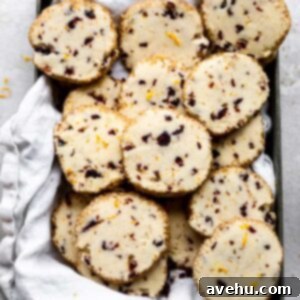
Melt In Your Mouth Cranberry Orange Shortbread Cookies
Pin
Review
SaveSaved!
Ingredients
- 1 cup (227 g) unsalted butter, softened
- 1/2 cup (60 g) confectioners sugar
- 2 tsp (2 tsp) orange zest, from 1 large orange
- 1/3 cup (40.4 g) dried cranberries, chopped
- 1 tsp (1 tsp) vanilla extract
- 2 cups (250 g) all-purpose flour
- 1/4 tsp (0.25 tsp) kosher salt
- 2 cups (400 g) turbinado sugar, for rolling
Instructions
-
Preheat the oven to 350°F (175°C) and line two rimmed baking sheets with parchment paper.
-
In a medium-sized bowl or the bowl of a hand or stand mixer fitted with the paddle attachment, cream the 1 cup unsalted butter and 1/2 cup confectioners sugar together on low speed until light and airy, about 30 seconds to 1 minute.
-
 Add the 2 tsp orange zest and 1 tsp vanilla extract and mix lightly to combine, ensuring the flavors are well distributed.
Add the 2 tsp orange zest and 1 tsp vanilla extract and mix lightly to combine, ensuring the flavors are well distributed. -
Add in 1/3 cup chopped dried cranberries, the 2 cups of all-purpose flour, and 1/4 tsp kosher salt. Mix on low speed until a unified, firm dough forms. Be careful not to overmix, as this can lead to tough cookies.
-
 Shape and roll the dough into an even log, approximately 1.5 to 2 inches in diameter. It’s helpful to wrap it lightly in plastic wrap or parchment paper and roll it on the counter to ensure an even shape. Chill the dough in the refrigerator for at least 1 hour, or up to overnight, until firm. This step is crucial for preventing spread during baking.
Shape and roll the dough into an even log, approximately 1.5 to 2 inches in diameter. It’s helpful to wrap it lightly in plastic wrap or parchment paper and roll it on the counter to ensure an even shape. Chill the dough in the refrigerator for at least 1 hour, or up to overnight, until firm. This step is crucial for preventing spread during baking. -
 Pour the 2 cups of turbinado sugar out onto a clean rimmed baking sheet or shallow dish. Remove the chilled dough log from its wrapping and roll it all over the sugar until it is completely and evenly coated on all sides.
Pour the 2 cups of turbinado sugar out onto a clean rimmed baking sheet or shallow dish. Remove the chilled dough log from its wrapping and roll it all over the sugar until it is completely and evenly coated on all sides. -
 Using a long, sharp serrated knife, employ a gentle sawing back and forth motion to cut the dough log into uniform slices, approximately 1/4 to 1/2 inch thick. Strive for evenness to ensure consistent baking and perfect cookie shapes.
Using a long, sharp serrated knife, employ a gentle sawing back and forth motion to cut the dough log into uniform slices, approximately 1/4 to 1/2 inch thick. Strive for evenness to ensure consistent baking and perfect cookie shapes. -
 Line the sliced cookies on the parchment-lined baking sheets, spacing them about 1 1/2 inches apart. Bake for 10-12 minutes in the preheated oven, or until the edges are lightly golden and the cookies feel firm to the touch. Remove from the oven and let them cool on the baking sheet for a few minutes before transferring to a wire rack to cool completely.
Line the sliced cookies on the parchment-lined baking sheets, spacing them about 1 1/2 inches apart. Bake for 10-12 minutes in the preheated oven, or until the edges are lightly golden and the cookies feel firm to the touch. Remove from the oven and let them cool on the baking sheet for a few minutes before transferring to a wire rack to cool completely.
Notes
Feel free to substitute other delicious add-ins for the cranberries and orange zest! Consider finely chopped nuts (e.g., pistachios, almonds, pecans) or different dried fruits (e.g., dried cherries, apricots, blueberries). Ensure any additions are small to integrate well into the dough.
It is crucial to use dried cranberries for this recipe. Do not use fresh or frozen cranberries, as their high moisture content will negatively affect the dough’s consistency and the final delicate texture of your shortbread.
